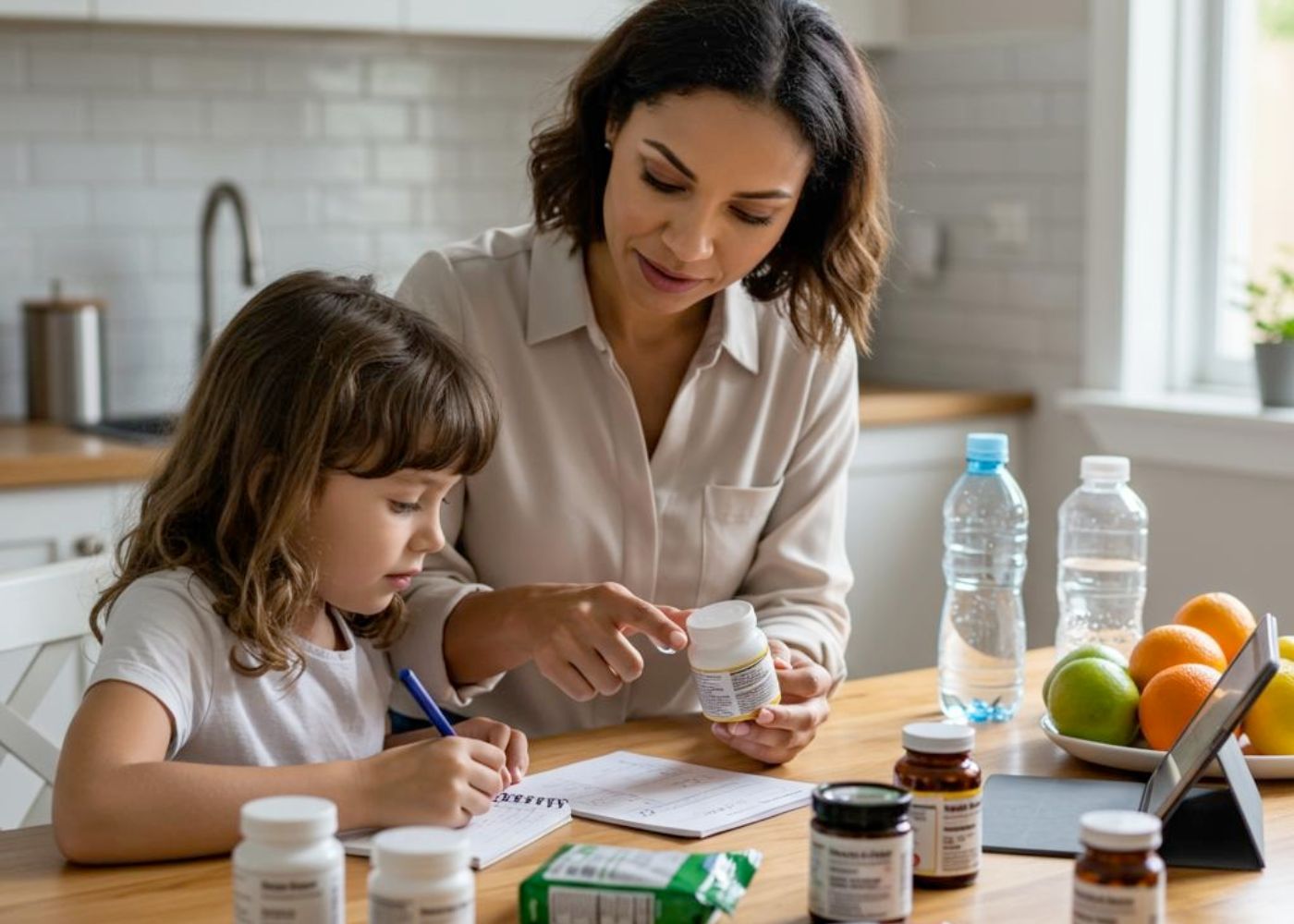
The Gummy Vitamin Dilemma: A Mom’s Journey Through the Supplement Maze
Standing in Target’s vitamin aisle with three kids in tow, I was overwhelmed by walls of colorful bottles that looked suspiciously like candy. My 4-year-old begged for “rainbow bears” while my 8-year-old confidently declared we needed ones with “brain power boost.” This should have been simple—I just wanted my kids to be healthy. But surrounded by marketing promises and bright packaging, I felt more confused than confident.
That moment changed everything. It forced me to ask the question I’d been avoiding: What am I actually giving my children?
The Wake-Up Call: When “Healthy” Became Dangerous
The turning point came on an ordinary Tuesday morning. I heard commotion from the pantry and found my 2-year-old sitting on the floor with an open bottle of gummy vitamins, orange residue around his mouth and that guilty toddler expression.
My hands shook as I dialed poison control. The technician asked pointed questions: How many did he eat? What was the vitamin A content? As I scrambled to read the tiny print, one fact hit me hard—these weren’t just expensive candy. They were medicine disguised as treats.
The poison control technician shared something haunting,
“Calls about children getting into supplement bottles have jumped significantly since gummy vitamins became popular. About 20% of all childhood poisoning cases now involve supplements.”
My “healthy choice” had become a safety hazard. If you’re concerned about accidental ingestion, knowing the vitamin overdose symptoms can help you respond quickly in an emergency situation.
After my son was cleared by our pediatrician (thankfully, he’d only eaten three), I couldn’t sleep. I realized I’d been calling them “special treats” and felt proud when my kids took vitamins without fighting. I was teaching them that medicine should taste like candy.
The Hidden Truth About Gummy Vitamins for Kids
My research started with a simple question: what’s actually in these things? The answer was eye-opening.
Truth #1: The Sugar Shock
Most gummy vitamins contain 2-8 grams of sugar per serving—sometimes more than actual gummy bears.
The American Academy of Pediatrics recommends kids have no more than 25 grams of added sugar daily, so a single vitamin serving can use up nearly a third of that limit.
Our dentist, Dr. Patterson, pulled me aside during my daughter’s checkup. “I’ve had three kids this month with serious decay, and the only common factor is daily gummy vitamins,” he told me.
The problem isn’t just sugar content—it’s how gummies stick to teeth and stay there, bathing tooth surfaces in sugar and citric acid.

Truth #2: The Absorption Problem
Despite what I’d assumed, not all nutrients work well in gummy form.
Iron, crucial for growing brains and preventing anemia, tastes too metallic to mask in gummies. Most brands leave it out entirely.
Calcium needs more space than a small gummy can provide, so amounts are often inadequate.
Independent testing has found that gummy vitamins are most likely to fail accuracy tests—meaning what’s on the label often isn’t what’s in the bottle.
The moist, chewy environment that makes gummies appealing also makes vitamins break down faster. For many parents struggling with the supplement maze, understanding the truth about gummy vitamins and their actual effectiveness is crucial for making informed decisions about children’s health.
And the cost? I was spending 300% more than traditional vitamins for products that often delivered less nutrition.
What Pediatric Experts Really Say About Gummy Vitamins
The research into what medical professionals actually recommend was sobering. The American Academy of Pediatrics believes that healthy children receiving a normal, well-balanced diet do not need vitamin supplementation over and above the recommended dietary allowances.
Johns Hopkins pediatricians warn against gummy vitamins because “they aren’t great on the teeth” and caution parents to never call vitamins “candy”.
One pediatrician recalled her brother eating an entire bottle of Flintstones vitamins as a child because he thought they were candy.
For parents still considering supplements, experts emphasize that gummy vitamins may not be the best choice if you’re concerned about added sugars, as some gummies contain several grams per serving.
The Age Trap: Why One Size Doesn’t Fit All for Children’s Vitamins
One of my biggest realizations was about age ranges. Most gummy vitamins are labeled for “children 2-12 years,” which is absurd when you think about it. That’s like saying the same pair of shoes should fit a toddler and a sixth-grader.
My 2-year-old needs 600 IU of vitamin D daily for growing bones. My 10-year-old needs the same amount of vitamin D but different amounts of other nutrients as she approaches puberty. Yet they were getting identical gummy formulations.
The safety considerations are completely different too. My toddler can’t distinguish between vitamins and candy, making overdose a real risk. My older kids can understand that vitamins are medicine, but they’re still drawn to the candy-like appeal.
For parents seeking evidence-based information about children’s vitamin safety, this comprehensive guide to kids’ gummy vitamins provides detailed analysis of safety concerns and alternatives.
Using Evidence-Based Solutions to Finding a Better Path
After months of research, I developed a completely new approach to family supplements.
First, I started with our pediatrician instead of the vitamin aisle. Dr. Martinez reviewed each child’s diet and growth patterns before recommending specific nutrients. My good eater didn’t need a multivitamin at all—just vitamin D since we live in a climate with limited winter sun. My pickier eater benefited from a few targeted nutrients rather than a kitchen-sink approach.
I changed how I think about supplement forms. For my toddler, I switched to liquid vitamin D that I can mix into food. No candy association, no overdose risk, and better absorption. My school-age kids now take chewable tablets that taste fine but clearly look like medicine.
When I do choose gummies—which is rare—I have strict criteria:
- Third-party testing (NSF or USP certification)
- Minimal sugar (under 2 grams per serving)
- Natural colors instead of artificial dyes
- Nutrients that actually work well in gummy form
Storage became a major priority. All supplements now live in a locked cabinet in our bathroom, not the kitchen where kids might see them as snacks.
Most importantly, I shifted to a food-first philosophy. Instead of hoping supplements would fix nutritional gaps, I focused on improving our family’s diet.
We make smoothies with spinach and berries, try new vegetables together, and I involve the kids in cooking. As a working mom, finding work-life balance tips became even more important when dealing with children’s health decisions and the stress of making the right nutritional choices.

What Parents Need to Know About Gummy Vitamins
Looking back, my confusion in that Target aisle wasn’t about being a bad parent—it was about being a parent in a system designed to exploit our love for our children. The supplement industry knows we’ll pay anything if we think it helps our kids.
Here’s what I wish I’d known:
- Start with your pediatrician, not the vitamin aisle. They can assess what your child actually needs based on diet and growth patterns.
- Read beyond the front label to understand what’s really inside. Look for third-party testing certifications and minimal added sugars.
- Consider the safety implications of candy-like vitamins. Nearly 70 percent of children’s vitamins come in gummy form, and hundreds of parents rush to emergency rooms each year with children who ate whole bottles.
- Food first, supplements second. Most children can get necessary nutrients from a balanced diet, making supplements unnecessary for many kids. This family supplements guide offers practical advice for busy parents navigating the supplement maze.
The American Academy of Pediatrics position on children’s vitamins provides the medical community’s official stance on supplementation for healthy children.
For many parents struggling with the supplement maze, understanding the truth about gummy vitamins and their actual effectiveness is crucial for making informed decisions about children’s health.
We’re also teaching our children important lessons about health marketing. When my kids see supplement commercials now, we talk about the difference between what companies want to sell and what our bodies actually need.
Empowering Responsible Gummy Vitamin Intake in Your Household
Our kids deserve better than glorified candy sold as nutrition. They deserve parents who ask hard questions, seek real answers, and make choices based on evidence rather than fear or marketing hype.
That anxiety I used to feel in the vitamin aisle has been replaced by confidence. I now know what my children actually need, why they need it, and how to provide it safely. That’s the kind of health advocacy I want to model for my children—and it started with questioning everything in aisle seven.
The supplement industry will continue marketing candy-like vitamins to our children, but we can choose differently. We can prioritize actual nutrition over marketing gimmicks, safety over convenience, and evidence over emotion. Our kids’ health—and their understanding of medicine versus treats—depends on it.

Morgan Taylor is a mother of 3. She founded Best Gummy Reviews after discovering shocking quality gaps during her own vitamin D treatment. With 8+ years in nutrition research, she combines lab science with real-world testing to tell you what actually works for the best gummy supplementation. Best Gummy Reviews is thorough but straightforward— supplements should complement your healthy habits, not replace them.



